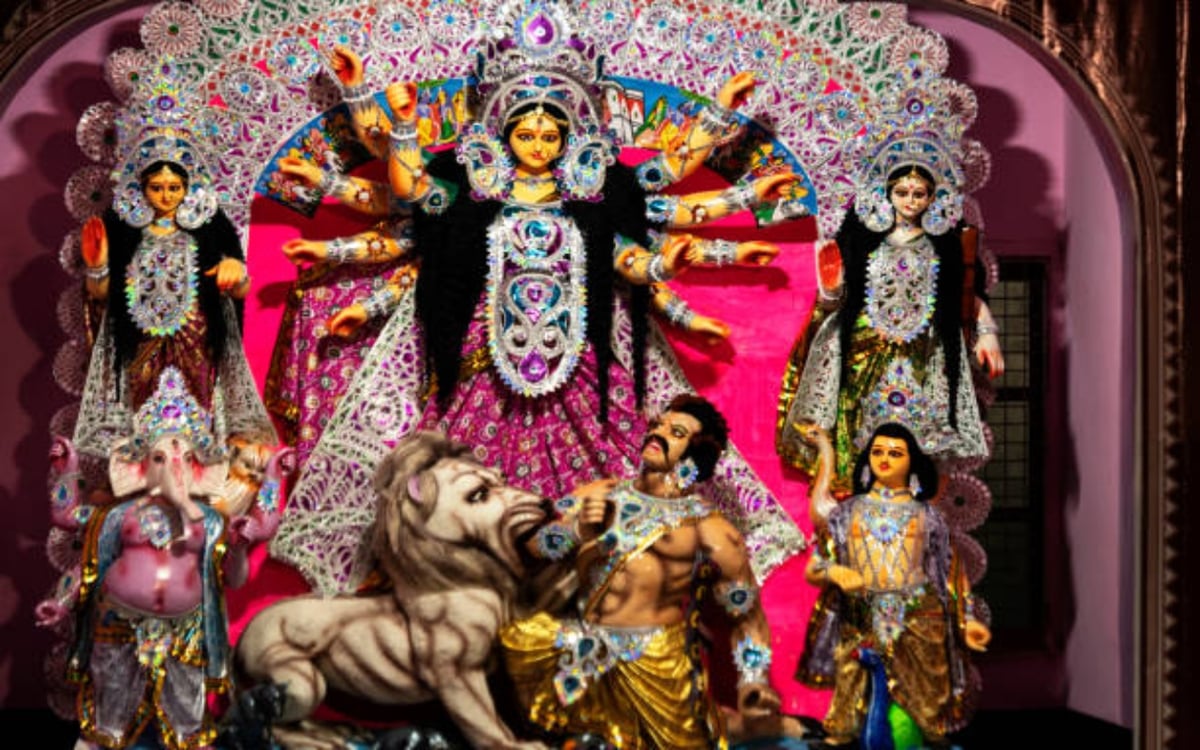


With Sharadiya Navratri just around the corner, devotees are getting ready to welcome Goddess Durga into their homes. The nine-day festival, which falls in October this year, sees the worship of various forms of Maa Durga. From Panchapallava to suhaag items, here's a complete list of worship material required for Navratri. Additionally, practices like donating to those in need and worshipping little girls are also an important part of the festival's rituals.
Ganges Navaratri Ghat Durga Puja Munger Kalsh: A Mystical Celebration
Introduction
The ancient city of Munger in Bihar, India, holds a special place in Hindu mythology and the celebration of Navratri. During this sacred nine-day festival, the banks of the Ganges River transform into a vibrant canvas of devotion and festivity. The Ganges Navaratri Ghat Durga Puja Munger Kalsh, a key ritual during the festival, holds immense significance for devotees.
Background
According to legend, Goddess Durga emerged from the forehead of Lord Shiva to defeat the demon Mahishasura. The battle took place on the banks of the Ganges River, and it is believed that the place where Goddess Durga's footprints fell became holy ground known as the Ganges Navaratri Ghat.
Durga Puja Munger Kalsh Ritual
The central ritual of Navratri in Munger is the Ganges Navaratri Ghat Durga Puja Munger Kalsh. It involves filling a silver or copper pot (kalsh) with water from the Ganges River. Devotees offer prayers and perform rituals to the Goddess Durga, seeking her blessings and protection. The kalsh is then carried to their homes and worshipped throughout the nine-day festival.
Significance
The Ganges Navaratri Ghat Durga Puja Munger Kalsh is considered highly auspicious and is believed to bring good luck, prosperity, and protection to devotees. The river Ganga is considered sacred in Hinduism, and its water is believed to have purifying and healing properties. By performing this ritual, devotees connect with the divine energy of the Goddess Durga and seek her blessings.
Top 5 FAQs
1. When is Ganges Navaratri Ghat Durga Puja Munger Kalsh celebrated? It is celebrated during Sharad Navratri, which generally falls in October.
2. What is the significance of the Ganges River in this ritual? The Ganges River is considered sacred, and it is believed that Goddess Durga's footprints fell on its banks during her battle with Mahishasura.
3. How is the Ganges Navaratri Ghat Durga Puja Munger Kalsh performed? Devotees fill a kalsh with Ganges water and perform prayers and rituals to Goddess Durga. The kalsh is then carried home and worshipped.
4. What are the benefits of performing this ritual? It is believed to bring good luck, prosperity, and protection to devotees.
5. Is it possible to perform this ritual outside of Munger? Yes, while the ritual is traditionally performed on the Ganges Navaratri Ghat in Munger, devotees can also perform it in their homes or at other temples.

The Delhi Traffic Police has announced special traffic arrangements for the upcoming Chhath Puja celebrations in the city. Heavy footfall is expected at major ghats and ponds in different parts of Delhi, leading to diversions and restrictions on various roads. Commuters are advised to use public transport and avoid areas with expected gatherings.

The holy relics will be taken in a grand Guru Charan Yatra through various cities in India before finding a permanent home at Takht Sri Patna Sahib, the birthplace of the tenth Sikh Guru. This marks a significant moment for the community and a way to deepen their connection with the teachings of Sri Guru Gobind Singh and Mata Sahib Kaur.

As festivities for Chhath Puja 2025 begin, schools in the national capital Delhi, as well as in Bihar, Uttar Pradesh, and Jharkhand, have announced closures on October 27, with additional holiday time for those in Bihar. In West Bengal, schools will be closed on October 31 for another significant festival, Jagadhatri Puja. With official announcements expected soon, students can look forward to enjoying the celebrations with their families.

The Hyderabad District Collector, Hari Chandana IAS, has launched India's first QR code-based feedback system at the Collectorate, marking a major step towards transparent and people-centric governance. This innovative system allows citizens to easily provide feedback, suggestions, and grievances in real-time, without the need for formal paperwork or technical skills. Along with promoting administrative efficiency and accountability, this initiative also promotes citizen participation and empowerment by enabling them to directly influence government operations at the local level.

Piyush Pandey, one of the most influential minds in Indian advertising, passed away on Thursday at the age of 70. Renowned for his iconic moustache and love for everyday stories, Pandey reshaped the industry by incorporating Hindi and Indian expressions, bringing humor, heart, and authenticity to mainstream brand communication. Indian Prime Minister Narendra Modi and Finance Minister Nirmala Sitharaman expressed their grief over the loss of Pandey, who was credited with revolutionizing Indian advertising and communication. His work will continue to inspire generations to come.

A private bus carrying 41 passengers caught fire after colliding with a motorcycle on National Highway 44 in Kurnool district, Andhra Pradesh. Preliminary police investigations suggest that the motorcycle's fuel tank ruptured and leaked fuel, causing the fire. The bus was reported to have multiple challans for traffic violations, and investigations are ongoing to determine the exact cause of the accident.

The Madhya Pradesh Police has launched a new campaign called 'Nashe Se Doori Hai Zaroori' to create awareness among the youth about the dangers of drugs and addiction. The campaign, which is being led by Indian Navy Chief Admiral Dinesh Kumar Tripathi, aims to highlight the importance of keeping the young generation drug-free in order to safeguard the country's future. Tripathi has urged everyone to understand their responsibility in creating a better India and to stay away from the path of destruction that substance abuse can lead to.

Studies have shown that surrounding yourself with greenery has significant benefits for mental health, including lower stress levels and improved mood. Engaging with indoor plants has been linked to reduced blood pressure and improved relaxation. A 2023 study also revealed that caring for indoor plants can increase mental well-being and emotional balance. Discover the top 12 indoor plants that can improve your health, happiness, and indoor air quality.

Devotees from all over India flocked to Vishram Ghat in Mathura to participate in the annual Bhai Dooj festival, a celebration of the special bond between brothers and sisters. The ancient Yamraj Temple was the center of the festivities as devotees took a dip in the holy Yamuna River and performed rituals to honor Yamraj and Goddess Yamuna. The festival is believed to bring blessings of long life, happiness, and prosperity to siblings and is a symbol of love and protection in Hindu mythology.

On the auspicious occasion of Bhai Dooj, Prime Minister Narendra Modi, Union Home Minister Amit Shah, and Union Health Minister JP Nadda extended their heartfelt wishes to the nation, celebrating the sacred bond between brothers and sisters. This festival, also known as Bhaiya Dooj, Bhai Tika, or Bhau Beej, is widely celebrated across India with love and festivity, symbolizing the unbreakable affection and dedication between siblings. The day holds great significance in Hindu mythology and is associated with the liberation of all living beings from suffering and the bestowal of happiness.